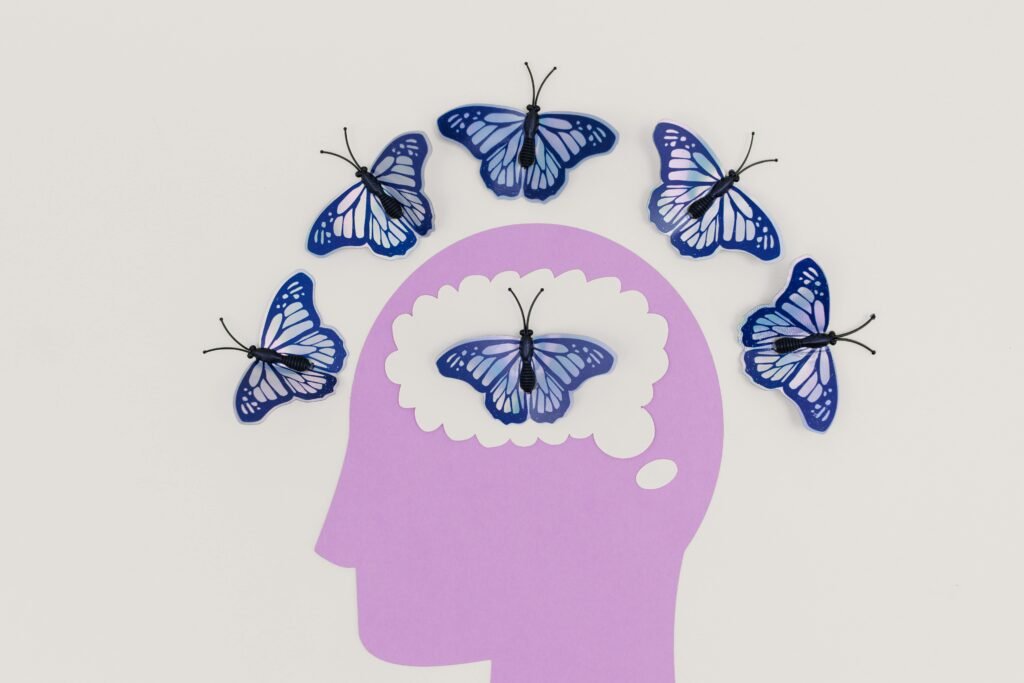
Introduction to Changing Thoughts
Changing your thoughts is a life-changing process that can significantly enhance your mental health and outlook on life.
It’s not just about flipping a mental switch; it’s about engaging in a series of deliberate practices that can help shift your thinking patterns.
Many of us experience ingrained negative thoughts that can be challenging to overcome, but by understanding how to change your thoughts, you can foster a more positive mindset.
One foundational aspect of changing your thoughts is recognizing that your mental habits are just that—habits.
Just as you can change a physical habit like biting your nails or skipping workouts, you can also alter your mental habits.
It starts with awareness: noticing when negative thoughts arise and acknowledging them without judgment.
Consider the example of self-doubt.
If you often find yourself thinking, “I’m not good enough,” this thought can hinder your ability to take on new challenges or enjoy your achievements.
Recognizing this pattern is the first step toward change.
Once you identify these negative thoughts, you can begin to reframe them into more constructive and empowering statements.
One effective way to initiate this shift is through cognitive restructuring, which involves identifying and challenging irrational thoughts.
For instance, if your inner dialogue says, “I’ll never be successful,” you can counter it with a more balanced thought like, “Success is a journey, and I am making progress every day.”
This practice helps to disrupt negative cycles and replace them with healthier thinking patterns.
Mindfulness is another powerful tool in this process.
By practicing mindfulness, you can develop a heightened awareness of your thoughts and emotions, allowing you to observe them without getting swept away.
Mindful practices such as deep breathing, body scans, and meditation can help you stay present and calm, making it easier to recognize and alter negative thoughts.
Incorporating positive affirmations and visualization techniques can further reinforce your efforts.
By consistently affirming positive statements about yourself and visualizing your goals, you create a mental environment that supports optimism and resilience.
Changing your thoughts is a dynamic and ongoing journey, requiring persistence and practice.
However, the benefits of a healthier mindset are well worth the effort.
Recognizing Negative Thought Patterns

Negative thoughts often manifest as self-doubt, pessimism, or critical self-talk.
These thoughts can influence how you perceive and react to situations.
For example, if you constantly think you’re not good enough, you might avoid taking on new challenges or opportunities.
Recognizing these patterns is the first step in changing them.
This underscores the importance of awareness in addressing negative thoughts.
Techniques to Reframe Thoughts

One effective method for changing negative thought patterns is cognitive restructuring.
This involves pinpointing irrational or harmful thoughts and transforming them into more positive or realistic ones.
For instance, if you catch yourself thinking, “I’ll never succeed,” you can reframe it to, “I am capable of achieving my goals with hard work and determination.”
By consistently practicing this technique, you can train your mind to adopt a more positive outlook.
Another helpful approach is to question the evidence behind your negative thoughts.
Often, our minds jump to conclusions without considering all the facts.
If you find yourself thinking, “I’m always failing,” take a moment to challenge that belief.
Ask yourself, “Is this really true?” and “What evidence do I have to support or refute this thought?”
By doing this, you can often uncover that these negative thoughts are based on assumptions rather than reality.
Journaling can also be a powerful tool in reframing your thoughts.
Write down your negative thoughts and then consciously replace them with more balanced and positive ones.
This process can help you see patterns in your thinking and make it easier to shift towards a healthier mindset.
For example, if you write, “I can’t handle this situation,” try to reframe it with, “I can find ways to manage this challenge effectively.”
Incorporating gratitude into your daily routine can further aid in reframing your thoughts.
When you focus on what you’re thankful for, it becomes easier to see the positive aspects of your life, which can counterbalance negative thinking.
Try to list a few things you’re grateful for each day, whether big or small.
This practice can help shift your overall perspective to a more optimistic one.
Additionally, using positive affirmations can reinforce the reframing process.
Affirmations are simple, positive statements that you repeat to yourself, such as “I am strong” or “I am capable.”
Over time, these affirmations can help change your internal dialogue and promote a more positive mindset.
Visualizing your success and positive outcomes can also be effective.
Spend a few minutes each day picturing yourself achieving your goals and overcoming challenges.
This mental imagery can make the positive scenarios feel more attainable and real, helping to shift your thoughts from doubt to confidence.
By integrating these techniques into your daily life, you can gradually reshape your thought patterns and cultivate a more constructive and empowering mindset.
Practicing Mindfulness

Practicing mindfulness is essential for enhancing awareness of your thoughts and emotions.
By engaging in mindfulness techniques, you can observe your thoughts without judgment, which makes it easier to identify and change negative patterns.
This illustrates that mindfulness practices can have a significant impact on brain function.
To incorporate mindfulness into your daily routine, start with simple exercises like deep breathing.
When you focus on your breath, you bring your attention to the present moment, reducing stress and increasing calmness.
Another effective technique is the body scan, where you mentally check in with each part of your body, noting any tension or discomfort.
This practice helps you become more in tune with your physical state and fosters a greater sense of relaxation.
Mindful meditation is another valuable tool. By setting aside a few minutes each day to meditate, you can train your mind to focus on the present and reduce the tendency to ruminate on negative thoughts.
Sit in a comfortable position, close your eyes, and concentrate on your breath.
When your mind wanders, gently guide it back to your breathing without judgment.
Over time, this practice can help you develop greater emotional resilience and clarity.
Additionally, mindfulness-based interventions have shown success in reducing substance use and heavy drinking days, highlighting their broader applications for mental well-being.
Another aspect of mindfulness is staying present during daily activities.
Whether you’re eating, walking, or even washing dishes, bring your full attention to the task at hand.
Notice the sights, sounds, and sensations you experience, and try to engage all your senses.
This practice not only grounds you in the present moment but also enhances your overall appreciation of life’s simple pleasures.
Incorporating mindfulness into your life may take time and effort, but the benefits for your mental and emotional health are profound.
Positive Affirmations and Visualization

Positive affirmations and visualization are transformative techniques that can help shift your mindset toward optimism and resilience.
By incorporating these methods into your daily routine, you reinforce positive thinking and open up new pathways for success and well-being.
Positive affirmations are simple, yet powerful statements you repeat to yourself to challenge and overcome negative thoughts.
These affirmations work by reprogramming your brain to focus on constructive beliefs.
For instance, start your day with affirmations like, “I am confident,” “I am capable,” or “I deserve happiness.”
By consistently repeating these statements, you build a mental foundation that supports a positive outlook.
Visualization, on the other hand, involves mentally picturing your goals and desired outcomes.
This technique helps you create a vivid image of success in your mind, making it easier to believe in and achieve those goals.
For example, if you have a big presentation at work, spend a few minutes each day visualizing yourself delivering it confidently and effectively.
See yourself succeeding, feeling proud, and receiving positive feedback.
This practice not only boosts your confidence but also primes your brain to recognize opportunities that can help you achieve your goals.
Combining positive affirmations with visualization can amplify the benefits of both practices.
As you repeat your affirmations, visualize the scenarios where these positive statements hold true.
For instance, if you affirm, “I am resilient,” picture yourself overcoming obstacles and emerging stronger.
This dual approach engages both your verbal and visual faculties, creating a more immersive and convincing experience.
To integrate these techniques into your daily routine, consider setting aside a few minutes each morning or evening for a dedicated practice session.
Find a quiet space where you can focus without distractions.
Close your eyes, take a few deep breaths, and begin with your affirmations.
Then, transition into visualization, allowing your mind to fully engage with the positive images you create.
You can also incorporate affirmations and visualization into your everyday activities.
While commuting, exercising, or even taking a shower, silently repeat your affirmations and visualize your success.
This continuous reinforcement helps ingrain these positive thoughts into your subconscious mind, making them more automatic and impactful over time.
Seeking Support and Professional Guidance

There are times when it’s beneficial to seek support from friends, family, or mental health professionals.
Having conversations with people who care about you can provide fresh perspectives and encourage positive thinking.
While personal efforts in changing your thoughts are crucial, professional guidance can offer a structured approach tailored to your unique needs.
Engaging with a mental health professional, such as a therapist or counselor, can be particularly valuable.
These experts are trained to help you identify and challenge deeply ingrained thought patterns that might be difficult to tackle on your own.
Therapy sessions can provide a safe and supportive environment where you can explore your thoughts and emotions without judgment.
Cognitive-behavioral therapy (CBT) is one evidence-based approach that can be highly effective.
CBT focuses on identifying negative thought patterns and replacing them with more balanced, realistic ones.
By working with a therapist, you can develop personalized strategies to reframe your thoughts and improve your mental well-being.
Support groups can also be a valuable resource.
Connecting with others who are experiencing similar challenges can provide a sense of community and shared understanding.
These groups often offer practical tips and emotional support that can reinforce your efforts to change your thoughts.
Online resources, such as mental health apps and virtual therapy platforms, offer additional avenues for support.
Many apps provide guided meditations, mood tracking, and tools for cognitive restructuring, which can complement your efforts to foster a healthier mindset.
Virtual therapy can be a convenient option for those who may find it challenging to attend in-person sessions.
Remember, seeking support is a sign of strength, not weakness.
It shows a commitment to your mental health and a willingness to use all available resources to achieve a positive change.
Whether you’re reaching out to friends, joining a support group, or consulting a mental health professional, these steps can significantly enhance your journey toward a healthier mindset.
By combining personal practices with external support, you can create a robust framework for changing your thoughts and improving your overall mental well-being.
Building a Consistent Practice

Consistency is crucial for changing your thoughts and fostering a positive mindset.
Implementing daily practices such as mindfulness, affirmations, and visualization can lead to lasting transformation.
Set aside dedicated time each day to focus on these activities, whether it’s a few minutes in the morning or before bed.
Using reminders or journaling can be helpful tools to keep you on track.
For instance, you can set daily reminders on your phone to practice deep breathing or positive affirmations.
Journaling your thoughts and progress can also provide insight into your mental habits and help you identify patterns that need changing.
This approach makes it easier to stay committed and see how far you’ve come over time.
Mindfulness practices, in particular, can have a significant impact when done regularly.
Start with simple exercises like focusing on your breath or conducting a body scan.
These activities don’t require a lot of time but can greatly enhance your awareness and help you manage stress more effectively.
Research has shown that Mindfulness-based interventions have shown moderate effects on improving eating attitudes and weight loss.
This illustrates the broader benefits of maintaining a consistent mindfulness practice.
Visualization can also be incorporated into your daily routine.
Spend a few moments each day picturing your goals and desired outcomes.
This not only boosts your confidence but also primes your mind to recognize opportunities for achieving those goals.
In addition to personal practices, seeking external support can reinforce your efforts.
Whether it’s through therapy, support groups, or mental health apps, leveraging these resources can provide additional structure and motivation.
For example, many mental health apps offer guided meditations and mood tracking, which can complement your daily practices and help you stay consistent.
Remember, the goal is to make these practices a regular part of your life.
By doing so, you create a solid foundation for changing your thoughts and cultivating a healthier mindset.
Consistency might require effort initially, but the positive changes in your mental well-being will make it worthwhile.
Conclusion and Encouragement

Embarking on the journey of changing your thoughts is both empowering and life-changing.
As you practice recognizing negative patterns and reframing them, you lay the groundwork for a more positive and resilient mindset.
The techniques discussed, including cognitive restructuring, mindfulness, positive affirmations, and visualization, are not quick fixes but tools that require dedication and consistency.
Remember, it’s normal to encounter challenges along the way.
Shifting deeply ingrained thought patterns takes time and effort, but every small step you take contributes to your overall progress.
Celebrate these small victories—they are crucial milestones in your journey toward mental well-being.
Building a support system can also be incredibly beneficial.
Engaging with friends, family, or professionals can offer fresh perspectives and valuable guidance.
Whether you seek the structured approach of therapy or the communal support of a group, leveraging these resources can amplify your efforts and provide much-needed encouragement.
Integrating these practices into your daily routine doesn’t have to be overwhelming.
Start with small, manageable changes like setting aside a few minutes each day for mindfulness or affirmations.
Consistency is key, and over time, these practices will become second nature, seamlessly blending into your everyday life.
It’s also essential to be patient with yourself.
Change is a gradual process, and setbacks are a natural part of the journey.
When you encounter obstacles, view them as opportunities for growth rather than failures.
Each challenge you overcome strengthens your resilience and reinforces your commitment to a healthier mindset.
As you continue this journey, you’ll likely find that the benefits extend beyond just your thoughts.
Improved mental clarity, reduced stress, and a greater sense of well-being are just some of the positive changes you can expect.
By staying committed to these practices, you’re investing in a brighter, more optimistic future.
So, take that first step today. Embrace the journey with an open heart and mind, and remember that every effort you make brings you closer to the positive change you seek.
Your future self will thank you for the dedication and perseverance you show today.
